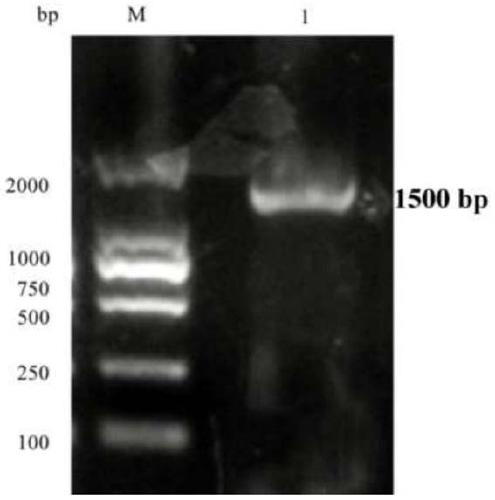Preparation method and application of recombinant fungal laccase
A technology of fungal laccase and recombinant strains, applied in the biological field, can solve the problems of limited industrial use and no tolerance, and achieve the effect of large application potential and good decolorization effect
- Summary
- Abstract
- Description
- Claims
- Application Information
AI Technical Summary
Problems solved by technology
Method used
Image
Examples
Embodiment 1
[0062] Example 1. Acquisition of Lac1 gene Lac1 of Trametes MX2 laccase
[0063] Collect in liquid enzyme production medium (g / L: glucose 20g, yeast extract 10g, potassium dihydrogen phosphate 2.0g, ammonium sulfate 2.0g, magnesium sulfate heptahydrate 0.5g, calcium chloride 0.1g) and shake (150rpm) Bacteria spheres cultured for 7-10 days (28°C) were ground into powder with liquid nitrogen, and used as materials to extract the total RNA of T. trachelves MX2 using an RNA extraction kit. Then, the cDNA was synthesized by reverse transcription using the cDNA synthesis kit using the total RNA of Trameteles MX2 as a template.
[0064] The cDNA synthesis reaction conditions are divided into two steps. First, mix 1 μL of Oligo dT Primer, 1 μL of dNTP Mixture, 2 μL of total RNA and sterile water to form a 10 μL reaction solution, and keep the reaction solution at 65°C for 5 minutes, and then rapidly cool it on ice . The second step is to mix the above 10 μL reaction solution with 4 ...
Embodiment 2
[0070] Embodiment 2, the construction of Pichia pastoris recombinant strain
[0071] ①. Construction of recombinant plasmid pPIC9K-Lac1
[0072] After connecting the recovered and purified PCR product in Example 1 to the pMD19-T cloning vector, transform Escherichia coli JM109, screen positive clones (containing Lac1 fragments), and then double digest the positive clones with EcoR I and Not I, and recover Lac1 fragments .
[0073] The pPIC9K plasmid was also digested with EcoR I and Not I to recover the pPIC9K vector fragment.
[0074] Finally, the recovered Lac1 fragment was ligated with the pPIC9K vector fragment and transformed into Escherichia coli JM109, and a positive single colony was picked on the LB solid medium containing kanamycin, and after shaking bacteria, plasmid extraction, EcoR I and Not I double After enzyme digestion verification ( figure 2 ), to confirm the construction of the correct recombinant strain JM109 / pPIC9K-Lac1, and the contained recombinant p...
Embodiment 3
[0079] Example 3, Screening and induction expansion of recombinant strains of Pichia pastoris with laccase activity
[0080] Several positive colonies in Example 2 were re-inoculated in a new MD medium, and each colony was numbered, and cultured at 28° C. for 3-5 days. Then take an inoculation loop of bacteria according to the colony number and inoculate them in 100 μL of BMMY liquid medium containing 1% methanol (V / V), and shake at 250 rpm at 28° C. for 24 hours. Then add 100 μL of 1M ABTS (dissolved in 0.1M sodium acetate pH 3.4 buffer) to the cultured BMMY liquid medium (that is, the culture result) for color reaction, observe after ≥30 minutes, the color of the liquid If it turns green or dark green, the colony corresponding to the number is the recombinant strain of Pichia pastoris with laccase activity ( Figure 5 ).
[0081] ABTS, ie, 2,2'-azino-bis-3-ethylbenzothiazoline-6-sulfonic acid.
[0082]The formula of 100 μL BMMY liquid medium containing 1% methanol (V / V) i...
PUM
| Property | Measurement | Unit |
|---|---|---|
| molecular weight | aaaaa | aaaaa |
Abstract
Description
Claims
Application Information
 Login to View More
Login to View More - R&D Engineer
- R&D Manager
- IP Professional
- Industry Leading Data Capabilities
- Powerful AI technology
- Patent DNA Extraction
Browse by: Latest US Patents, China's latest patents, Technical Efficacy Thesaurus, Application Domain, Technology Topic, Popular Technical Reports.
© 2024 PatSnap. All rights reserved.Legal|Privacy policy|Modern Slavery Act Transparency Statement|Sitemap|About US| Contact US: help@patsnap.com










